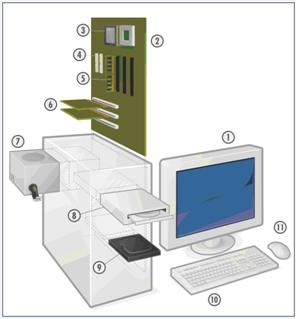The following diagram illustrates the main hardware components of a typical PC.
The circled numbers in the diagram correspond to the item numbers in the table.
| tem No | Name | Description |
| 1 | Monitor | Sometimes called a screen, this is the main output device of any computer. It can display the results of all inputs to the computer and from any network to which it may be attached. The most common output is generated by keyboard and mouse. |
| 2 | Motherboard | The main printed circuit board in a computer. Typically, in a PC, all other components are attached or connected to the motherboard in some way as can be seen by the examples in the above diagram. |
| 3 | CPU – Central Processing Unit | The heart of the computer, this is the component that actually executes instructions. The CPU is contained on a single Silicon Chip and is called a microprocessor. |
| 4 | ATA - Advanced Technology Attachment | This facility is for connecting storage devices such as hard disks, solid-state disks and CD-ROM drives inside personal computers. |
| 5 | RAM – Ready Only Memory | The memory module is a small integrated circuit card also referred to as a RAM chip or stick. RAM is volatile memory, which means that any information stored in RAM memory is lost when the power to it is lost. RAM stores data and programs while they are being used. |
| 6 | Expansion Cards | There are several integrated circuit card connectors on Motherboards called Expansion Slots. These can be used to plug in a range of extra cards for specific functions, e.g. video, modem, TV & radio, extra USB ports etc. |
| 7 | Power Supply | This is essentially a power converter for taking the AC power from the mains supply and converting it to low voltage DC to power the various computer components. |
| 8 | Optical Disk Drive | These disk drives are used to either: Read the information on the disk and accept instructions for using it, e.g. loading software and accessing files to playing music or videos Record any form of data or files for storage or use by replaying the disk Not all optical drives can read and / or record all the various types of optical disk media available. |
| 9 | Hard Disk Drive | The hard disk unit contains several disk platters in a stack with dedicated reading and writing heads on arms to scan the disk surfaces. It is the primary storage facility for all software that is typically referred to as being on the PC. |
| 10 | Keyboard | The primary input and human interface device for a computer. The keyboard has the traditional alphanumeric typewriter keys and a series of specialised keys that can perform all the required input functions for using the installed software. |
| 11 | Mouse | This is a pointing device that controls the cursor / pointer on the screen for easy navigation of Windows style applications (i.e. GUIs) to execute functions and position the cursor. |
Computer Peripherals
Numerous components can be connected to a PC. Many of these are referred to as computer peripherals because in the early days of computing and in the home they are generally located near the main computer case.
The more common peripherals components are:
· Printers
· Speaker systems
· Modems
· Routers
· Cameras
· Game controllers
· UPS – Uninterruptible Power Supply
· External storage devices, e.g. hard disks and flash memory
The above components will be fully described in later revisions of this guide.

No comments:
Post a Comment